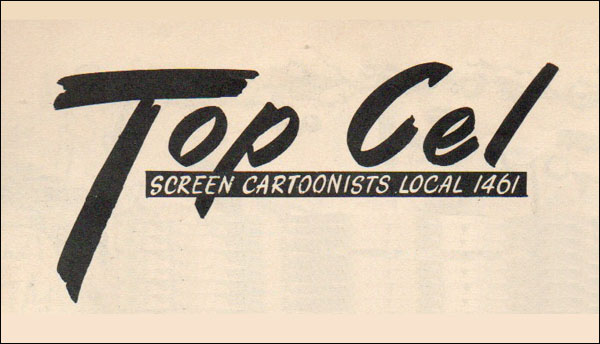
After gaining a foothold in the big West Coast animation studios, the Screen Cartoonist Guild decided it was time to breach the high-rise canyons of New York City, where the conflict had started a few years before. The world was in flux that June of 1943—it was at war. The SCG opened a local chapter through efforts of union advocates in Famous Studios on 42nd Street. Local 1461 also had support from employees of Terrytoons in the nearby suburb of New Rochelle. The US government in power wanted workers content and productive. The War Labor Board had an office in the Candler Building on 42nd Street to look after that very thing.
SCG organizers moved between the War Labor Board office and the bars or diners around Times Square, arguing their cause and recruiting new members: animators, inkers, opaquers, background painters, cameramen, checkers, inbetweeners, writers, layout men; they were all asked to join together for mutual protection. People had real problems; family members were in military service, as were a lot of animation artists—both men and women. Robinson McKee, the first president of Local 1461 was entering the Army Signal Corps assigned to Astoria, Long Island. Robinson McKee was also the plaintiff in a War Labor Board lawsuit against Terrytoons.
Elated by victory when Robinson McKee won his case in December 1943, the folks of Local 1461 celebrated by putting out a brag sheet, a newsletter called Top Cel. Hollywood’s Local 852 already published a newsletter titled The Animator. Hollywood held this new East Coast branch under close scrutiny. Resources couldn’t be spared unless the Times Square organizers brought in results. New York proved worthy. Hollywood sent business agent Pepe Ruiz to be Local 1461’s bulldog.
1461 took a space at Salmon Towers on 42nd Street, just a block away from Famous Studios. They were digging in on Sam Buchwald’s doorstep. With little more than a coffee pot, a typewriter, and an ashtray to work with, Top Cel got released every two weeks. True Believers from Famous Studios used the Salmon Towers space to put the newsletter together. The masthead was quickly penciled bubble letters, no doubt done with a pencil pilfered from Famous Studios. Inbetweener Shirley Knoring emerged as the editor.

Women as inbetweeners became common during the war, with so many men away. Women had opportunity in this topsy-turvy era. Judy Weiner, a colorist, assisted production of Top Cel beside animators Larry Riley and Eli Levitan. They were all from Famous.
Top Cel began life as a homey little newsletter to inform members of the trade about current union activities, notice of meetings, changes in pay rates, and where to write members serving in the military. The FLIPPINGS column acted as a community bulletin board, reporting births, deaths, weddings, promotions, and who was working at a little general service studio.
Members were gambling on Local 1461 succeeding, because their very membership branded them as unemployable if it failed. They were all in too deep to back down at that point. Pepe Ruiz and Sam Buchwald snarled at each other long enough that SCG officials secured a contract with Paramount Pictures, which owned Famous Studios. Local 1461 also represented people enlisted in the Army’s Signal Corps unit at Astoria, but the War labor Board was an ally there. Animation was “essential” to the war effort.
Union elections were held midway through 1944. Animator Orestes Calpini became president of Local 1461. The entire executive board was from Famous Studios: Dave Tendlar acted as treasurer, John Gentillela as conductor, and Shirley Knoring as recording secretary. Bill Henning and Morey Reden were chosen as delegates to the board from Famous. Assistant animator Woody Gelman, just out of military service, took over as Top Cel editor with Shirley Knoring and Judy Weiner’s help. The masthead was now a simple typed affair.

That December Top Cel printed its first piece of artwork, a Santa Claus with a massive beard, drawn by Dave Tendlar, adorned the cover. Into Santa’s beard Joe Geteri lettered the names of one hundred union members then doing military service. Top Cel was mailed to those people, so Woody Gelman asked them to send in drawings of military life inn other countries. Top Cel printed letters from their members in the service. One from Corporal Perry Rosove, tail-gunner in a B-29 bomber plane, was vehemently pro-union.
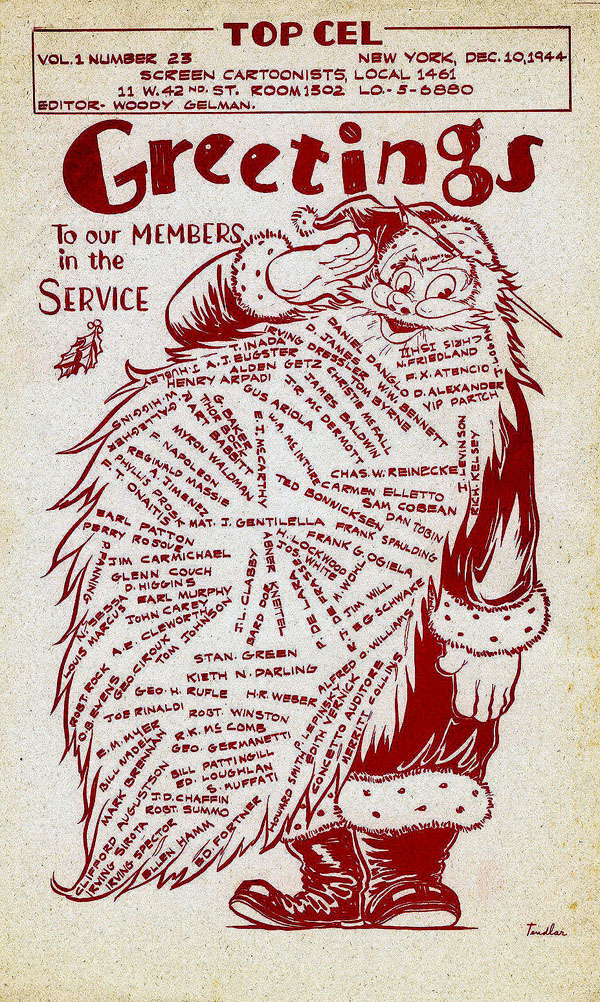
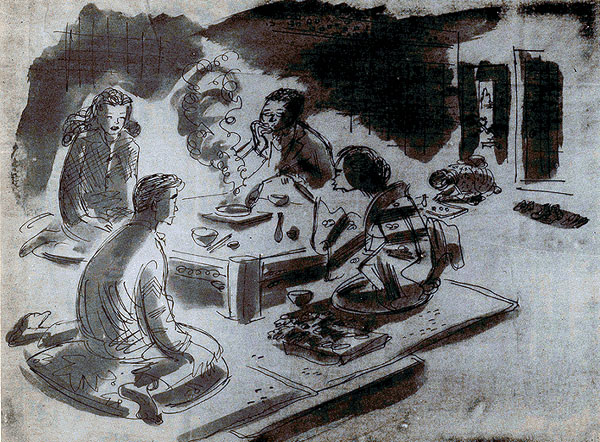
Chris Ishii from China
The World War ended. The National Labor Relations Board replaced the War Labor Board. Animation was no longer essential, but the Army kept the Long Island functional with a scaled back crew. Woody Gelman expounded on the virtues of racial equality in the pages of Top Cel, promoting an undivided work force. Fletcher Smith Studios signed with the union, leading the way for smaller general service shops. The SCG abandoned Salmon Towers, and union business was conducted out of an address Pepe Ruiz kept on Riverside Drive. Top Cel went monthly; the November 1945 issue appeared with a fancy new masthead by Pete Caldera of Fletcher Smith’s studio.
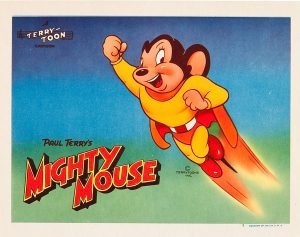 The SCG went to work on Terrytoons. Paul Terry proved a tough nut to crack. Union meetings alternated between the Capitol Hotel on 8th Avenue in Manhattan and the Cameo Movie House in New Rochelle, about four blocks from Terrytoons. April of 1945 saw a Contract Committee of Terrytoons workers formed in anticipation of a coming contract. General service studio Willard Pictures signed with the union.
The SCG went to work on Terrytoons. Paul Terry proved a tough nut to crack. Union meetings alternated between the Capitol Hotel on 8th Avenue in Manhattan and the Cameo Movie House in New Rochelle, about four blocks from Terrytoons. April of 1945 saw a Contract Committee of Terrytoons workers formed in anticipation of a coming contract. General service studio Willard Pictures signed with the union.
Top Cel existed as the crux of Local 1461’s social life. A party was held by the dance committee. Others organized a bowling tournament. Cartoon films of interest were shown after meetings. Woody Gelman quit animation to become a book publisher. Others kept Top Cel going on schedule, but the tone shifted.
While their protracted struggle with Terrytoons dragged on, Local 1461 focused on recruiting smaller studios. Cineffects and Film Graphics came into the fold. Sound Masters followed. All meetings were now held in Manhattan.
Minitoons, a commercial studio founded by Joe Magro, Robert G. Leffingwell, and Wilbur Streech, refused to allow the union in. That summer Orestes Calpini finished out a second term, handing the presidency over to John Gentilella. Firebrand Perry Rosove, then working at Minitoons, was sworn in as vice president and took over the editorship of Top Cel. Franklin Roosevelt, that great friend of unions, had died. Harry Truman showed them much less support.
Opinions about the new direction of Top Cel were divided. One reader stated that they admired the friendliness and spontaneity it portrayed. Another reader declared it too political, that it was turning into a propaganda sheet. Perry Rosove pushed it farther in that latter direction. Rosove could lay the rhetoric on a bit thick. Not everyone appreciated the change.
Perry Rosove, who risked his life flying combat missions over Europe had killed men to defend democracy. Now other veterans who ran Minitoons were locking him and his fellow employees out to avoid union oversight. Rosove had been trained to fight, so he did. Only many members just wanted to forget the war and move forward. Factions formed. Shirley Knoring was financial secretary. She only freelanced in animation by then, having found some work in book illustration. Treasurer Dave Tendlar, still slinging a pencil at Famous, supervised the Local’s purse strings with her. Tendlar seems to have been Top Cel’s de facto Art Director.
Members voted to make Top Cel the official source of notification for posting the union’s rule changes. Editorial sniping and griping increased. It was stated that President Harry Truman suffered from foot-in-mouth disease. The current anti-Communist fervor in the nation’s capitol was dubbed the “Age of Delirium Trumans”.
Dwinell Grant, supervisor of animation at Willard Pictures, formed a studio. Sturgis-Grant Productions immediately signed with the union, hiring Orestes Calpini to helm animation. Famous Studios continued to wrangle, but were not wholly uncooperative. Sam Buchwald played the inbetweeners against each other to get more work out of them. Terrytoons threw every dirty trick they could at 1461, culminating in a two-week lockout, followed by layoffs. A strike was called. Picket lines went up outside Terrytoons studio and theaters screening their cartoons. Top Cel printed pictures of workers who crossed the picket line, calling them “scabs”. Two union members were expelled for such activity.
When the ballots were counted in 1947 Gordon Whittier was president, bumping John Gentillela to V.P. Both men had been fired from Terrytoons due to their union activities and went on to animate for Famous. Dave Tendlar retained the office of Treasurer, soundly defeating his challenger, Bill Henning. Perry Rosove continued as editor of Top Cel.
At the June meeting, Morey Reden, Cliff Augustson and Saul Kessler began insulting Bill Henning. President Gordon Whittier never banged the gavel to stop it. Henning walked out of the meeting, accompanied by Al Eugster, George Rufle, Bill Turner, George Germanetti, and five others. The Hennings faction were all fined for disrupting the meeting. In turn he wrote a letter which seemed to compare Top Cel’s policies with Stalin and Hitler. He dared them to print it. Top Cel complied.
As the Terrytoon strike moved into its fourth month, Local 1461 was a house divided against itself, with the fate of Top Cel hanging in the balance.
To Be Continued in Part 2…


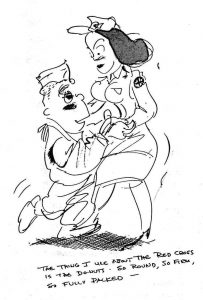
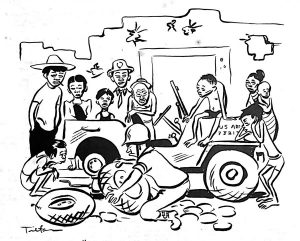
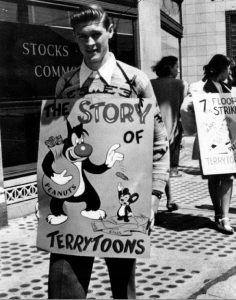
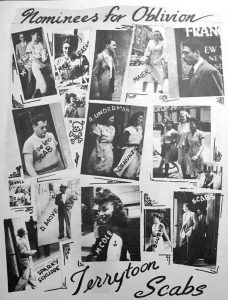
 BOB COAR made his way in this world as a muralist and sign painter, illustrating on just about every surface imaginable. A life-long fan of animation, he is currently searching for digital, or actual, copies of Top Cel.
BOB COAR made his way in this world as a muralist and sign painter, illustrating on just about every surface imaginable. A life-long fan of animation, he is currently searching for digital, or actual, copies of Top Cel. 



































Just to correct a small bit of historical error, the article says that CPL Perry Rosove was a tail-gunner in a B-29 serving in the European Theater. The B-29 Superfortress was used exclusively in the Pacific theater in the war against Japan. 1) Perry either served in the Pacific Theater in a B-29 or 2) he served in the European Theater in either a B-17 Flying Fortress or a B-24 Liberator. Please don’t think that I am trying to be an “Annoyance in the Backside”, I am just trying to clarify history.
Two questions:
1) Robinson McKee’s lawsuit against Terrytoons seems to have been a key event in the formation of Local 1461. What was it about?
2) Under the Selective Service Act, employers were required to hire back returning servicemen to their old jobs, even if this meant displacing other employees. I recall reading (and I’m sorry, but I don’t remember any specific names) that some employees at Famous Studios during the war, who were 4-F because of health reasons, lost their jobs to returning veterans, were unable to find other work in the field and died soon after. Was this issue ever discussed in Top Cel?
I always did like Terrytoons. There’s not much “art”, but heck its just a cartoon.
Okay, but the union didn’t do much when the Disney 2D crew–including my better half–got dumped without so much as a severance package. Afterward, a few of them gathered at our house to commiserate with each other, and one of them said they should have seen the writing on the wall. Whereupon I said, “Mickey Mickey tekel upharsin,” and nobody got it.
That’s nothing. I once used the phrase “prodigal son” in a room full of educated people, mostly medical doctors, and none of them had any idea what I meant. If it’s any consolation, your comment gave me the biggest laugh of the week so far. Thou art weighed in the balance and found high-larious!
To Jim Cleveland, I apologize for my sloppy research and appreciate the info.
To Paul Groh, I’m attempting to get all Top Cels posted on Prelinger Archives for free download. McKee was fired alongsid Sam Singer for union activism. Terry had to reinstate them both with back pay. Eli Levitan got bounced out of the camera department at Famous due to a returnin veteran.
To Andy Pandy I quote Gully Jimson. “Art has a lot to answer for!” Terrytoons are fast-paced, free-wheeling romps. They’re perfect.
To Hans Christian Brando – quoting Mickey in Yiddish probably caused Walt to roll over in his cryo-chamber.
” Quoting Mickey in Yiddish probably caused Walt to roll over in his cryo-chamber.”
Except for the fact that Walt was not Anti-Semitic (and was cremated).
Sorry, but I’m getting plenty sick of those jokes about those rumors.
No apology necessary, Bob. Just sharing what I know.
Thanks for answering my questions, Bob, and for sharing your research on this chapter in cartoon history. I also share your appreciation of Terrytoons. And incidentally, not that it matters to anyone but bible scholars, the quote Hans referenced above is in Aramaic, not Yiddish.
Thanks for the article. Very interesting and informative! What a fight to get unionized, though. It’s seems they’ve gone four years without making crucial inroads into Terry and Fleischer in just this short article. Whew!
Michael Sporn used to have full scans of “Top Cel” issues on his infamous “Splog” – there were all kinds of wonderful quick sketch illustrations by animators like Len Glasser, Hal Silvermintz and many more.
Sadly, it appears that within the past few months the Splog domain finally expired. I’m assuming it was kept up by a family member since Sporn’s passing in 2014. To say it was invaluable resource would be an understatement. I don’t know that there is another animation resource on the internet quite like it, and I would the archive for research and reference almost weekly.
If anyone is kind enough to upload issues like discussed previously, that would be fantastic.